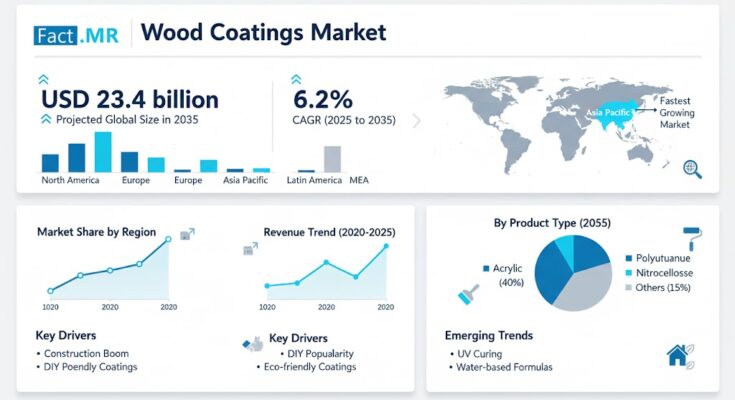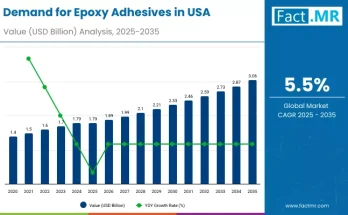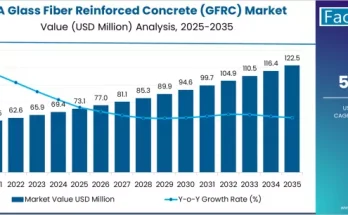The global wood coatings market is witnessing robust expansion, driven by rising demand from furniture, construction, and flooring applications. According to a recent report by Fact.MR, the market is valued at USD 12.0 billion in 2025 and is projected to reach USD 23.4 billion by 2035, expanding at a CAGR of 6.2% during the forecast period.
As industries and consumers increasingly seek coatings that enhance durability, visual appeal, and sustainability, wood coatings are becoming integral to both commercial and residential applicationsranging from furniture and flooring to architectural structures and decorative panels.
Strategic Market Drivers
- Booming Construction and Furniture Sectors
Global urbanization and rising disposable incomes have boosted demand for high-quality furniture and interior decoration, fueling the growth of the wood coatings market. These coatings protect wooden surfaces from moisture, UV exposure, and abrasion while providing an attractive finish.
In the construction industry, wood coatings are extensively used for architectural joinery, paneling, and decorative applications, particularly in premium residential and hospitality projects. The push for eco-friendly housing and sustainable infrastructure is also increasing the use of low-VOC and water-based wood coatings.
- Growing Popularity of Water-Based and UV-Curable Coatings
Shifts in environmental regulations and consumer preferences are accelerating the transition from solvent-based to water-based and UV-curable coatings. These formulations offer enhanced safety, reduced odor, and minimal environmental impact while delivering superior performance in terms of adhesion, flexibility, and gloss retention.
Manufacturers are investing heavily in bio-based resin systems and nanotechnology-infused coatings that improve scratch resistance and extend surface longevity, further driving innovation in the sector.
- Expanding Demand from Flooring and Joinery Applications
Wood coatings are seeing rising adoption in flooring, cabinets, and decorative applications due to their ability to enhance aesthetic appeal while protecting against daily wear and tear. Increasing consumer interest in custom and luxury furniture is encouraging manufacturers to develop coatings that provide high gloss, matte, or textured finishes tailored to regional design trends.
Browse Full Report: https://www.factmr.com/report/4538/wood-coatings-market
Regional Growth Highlights
East Asia: The Manufacturing Powerhouse
East Asia leads the global wood coatings market, with China, Japan, and South Korea at the forefront of production and consumption. Rapid industrialization, booming real estate development, and a growing furniture export industry underpin regional dominance. Government incentives promoting green chemistry and eco-labeled coatings further enhance the market’s sustainability credentials.
North America: Innovation and Eco-Friendly Formulations
In the United States and Canada, demand for low-emission and high-performance coatings is on the rise, supported by stringent environmental regulations and consumer awareness. The region’s thriving home improvement sector and premium wood product manufacturers continue to adopt next-generation coating technologies emphasizing efficiency and aesthetics.
Europe: Driven by Sustainability and Design Excellence
Europe’s wood coatings market is defined by innovation, strict sustainability standards, and a deep-rooted tradition in furniture craftsmanship. Countries like Germany, Italy, and France are major hubs for advanced coating production, emphasizing VOC-free, water-based formulations. The European Union’s Green Deal initiatives are accelerating R&D investments in sustainable surface technologies.
Emerging Markets: Rising Urbanization and Industrial Growth
Latin America, South Asia, and the Middle East are witnessing strong growth due to rapid infrastructure development and increasing local furniture manufacturing. The growing middle-class population and expanding real estate activities are fueling demand for protective and decorative coatings in residential and commercial spaces.
Challenges and Market Considerations
While the growth outlook remains positive, the wood coatings market faces several challenges:
- Raw Material Price Volatility: Fluctuations in resin and pigment costs affect pricing strategies and margins.
- Environmental Regulations: Stricter VOC and hazardous material restrictions require reformulation of traditional products.
- Competition from Substitutes: Laminate and synthetic alternatives pose challenges in certain furniture applications.
- Supply Chain and Energy Costs: Rising logistics and energy expenses influence production efficiency and cost competitiveness.
Competitive Landscape
The global wood coatings market is highly competitive and innovation-driven, with companies focusing on product sustainability, advanced formulation technology, and performance optimization.
Key Companies Profiled:
- Akzo Nobel N.V.
- PPG Industries, Inc.
- Nouryon
- Sherwin-Williams Company
- BASF SE
- Dow Chemical Company
- Valspar Corporation
- RPM International Inc.
- Nippon Paint Co. Ltd.
- Arkema SA
- Ashland Inc.
Leading manufacturers are expanding regional manufacturing footprints, launching eco-friendly coatings, and leveraging digital color-matching and smart application technologies to meet evolving customer needs.
Recent Developments
- July 2023 – Akzo Nobel N.V. expanded its waterborne wood coating range with improved resistance to moisture and yellowing for furniture and flooring.
- May 2023 – Sherwin-Williams introduced its Ultra Durable Clear Coat line, targeting high-end cabinetry and architectural finishes.
- December 2022 – BASF SE unveiled a bio-based polyol system for sustainable coating production, aligning with global decarbonization goals.
Future Outlook: Toward Sustainable and Smart Surface Finishing
The next decade will see the wood coatings industry embrace sustainability, digital innovation, and advanced material engineering. With the advent of AI-based color prediction systems, bio-based resins, and UV-curable nanocoatings, manufacturers are redefining performance standards.
As consumer preferences evolve toward natural aesthetics, environmental compliance, and longer-lasting finishes, the wood coatings market is set for significant and sustained growth. Companies that innovate with eco-friendly technologies, smart coating systems, and region-specific formulations will lead the transformation—delivering durable, beautiful, and sustainable wood surfaces for a greener future.



